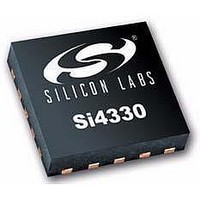Si4330-V2-FM Silicon Laboratories Inc, Si4330-V2-FM Datasheet - Page 46

Si4330-V2-FM
Manufacturer Part Number
Si4330-V2-FM
Description
RF Receiver RECEIVER EZRadioPRO UNIVERSAL ISM BAND
Manufacturer
Silicon Laboratories Inc
Type
ISM Receiverr
Datasheet
1.SI4330-B1-FM.pdf
(64 pages)
Specifications of Si4330-V2-FM
Package / Case
QFN-20
Operating Frequency
240 MHz to 960 MHz
Operating Supply Voltage
1.8 V to 3.6 V
Maximum Operating Temperature
+ 85 C
Minimum Operating Temperature
- 40 C
Mounting Style
SMD/SMT
Supply Current
100 nA
Lead Free Status / RoHS Status
Lead free / RoHS Compliant
Si4330-B1
8.6. Wake-Up Timer and 32 kHz Clock Source
The chip contains an integrated wake-up timer which can be used to periodically wake the chip from SLEEP mode.
The wake-up timer runs from the internal 32.768 kHz RC Oscillator. The wake-up timer can be configured to run
when in SLEEP mode. If enwt = 1 in "Register 07h. Operating Mode and Function Control 1" when entering SLEEP
mode, the wake-up timer will count for a time specified defined in Registers 14–16h, "Wake Up Timer Period". At
the expiration of this period an interrupt will be generated on the nIRQ pin if this interrupt is enabled. The
microcontroller will then need to verify the interrupt by reading the Registers 03h–04h, "Interrupt Status 1 & 2". The
wake-up timer value may be read at any time by the wtv[15:0] read only registers 13h–14h.
The formula for calculating the Wake-Up Period is the following:
Use of the D variable in the formula is only necessary if finer resolution is required than can be achieved by using
the R value.
There are two different methods for utilizing the wake-up timer (WUT) depending on if the WUT interrupt is enabled
in “Register 06h. Interrupt Enable 2,” on page 69. If the WUT interrupt is enabled then nIRQ pin will go low when
the timer expires. The chip will also change state so that the 30 MHz XTAL is enabled so that the microcontroller
clock output is available for the microcontroller to use to process the interrupt. The other method of use is to not
enable the WUT interrupt and use the WUT GPIO setting. In this mode of operation the chip will not change state
until commanded by the microcontroller. The different modes of operating the WUT and the current consumption
impacts are demonstrated in Figure 21.
A 32 kHz XTAL may also be used for better timing accuracy. By setting the x32 ksel bit in “Register 07h. Operating
& Function Control 1," GPIO0 is automatically reconfigured so that an external 32 kHz XTAL may be connected to
this pin. In this mode, the GPIO0 is extremely sensitive to parasitic capacitance, so only the XTAL should be
connected to this pin with the XTAL physically located as close to the pin as possible. Once the x32 ksel bit is set,
all internal functions such as WUT, micro-controller clock, and LDC mode will use the 32 kHz XTAL and not the
32 kHz RC oscillator.
46
Add R/W Function/Description
14
15
16
17
18
R/W
R/W
R/W
R
R
Wake-Up Timer Period 1
Wake-Up Timer Period 2 wtm[15] wtm[14] wtm[13] wtm[12] wtm[11] wtm[10] wtm[9] wtm[8]
Wake-Up Timer Period 3
Wake-Up Timer Value 1
Wake-Up Timer Value 2
wtv[15] wtv[14] wtv[13] wtv[12] wtv[11]
wtm[7]
WUT Register
wtv[7]
D7
wtm[15:0]
wtd[1:0]
wtr[3:0]
WUT
wtm[6]
wtv[6]
D6
4
Rev 1.0
wtm[5]
32
wtv[5]
wtr[3]
M Value in Formula
D5
R Value in Formula
D Value in Formula
M
.
768
Description
2
wtm[4]
wtv[4]
wtr[2]
R
D4
ms
wtm[3]
wtv[3]
wtr[1]
D3
wtv[10]
wtm[2]
wtv[2]
wtr[0]
D2
wtm[1] wtm[0]
wtd[1]
wtv[9]
wtv[1]
D1
wtd[0]
wtv[8]
wtv[0]
D0
POR Def.
00h
00h
00h
—
—











